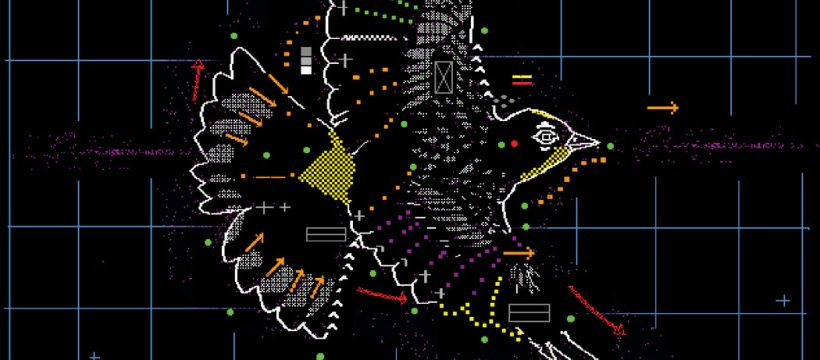Some events are simply too big for us to fathom. Bird migration, for instance, happens twice a year on a planetary scale that bruises the brain, so we’re forced to look for evidence in the traces around us: Skeins of geese and vanguards of vireos in the sky; a four-day mob of warblers passing through the neighborhood on their way from somewhere to somewhere else. A waxwing slain beneath a living-room window, its biannual journey stopped dead by the sky in a pane of glass. The Baltimore oriole that arrives in the yard next to mine every May 1 or 2 and starts advertising his availability for a mate. Up to 3.5 billion birds and more than 600 species migrate across North America each spring, mostly at night, but usually we can see them only looking up from the ground.
BirdCast lets us look down from above, and that changes everything. A joint project of the Cornell Lab of Ornithology, Colorado State University and U. Mass Amherst, it’s a website that lets us see them from a vantage point hundreds of miles above Earth, capturing each night’s continental migration as collected by over 140 radar stations across the country — data gathered about birds on the wing. The site went live to the public in 2018, around the time my own birding was deepening from a lifelong side project into something more personally, even spiritually, necessary — a way of being in the world that I had trouble finding elsewhere. After 40 mostly satisfying years as a film critic, I began to feel all those imagined visions closing around my head. I yearned to shake them off, to return to reality; birding has come to seem one of the more graceful ways to do that. (So has Zen meditation, and the overlap between the two can at times be nearly complete: Each activity teaches you to be acutely present while encouraging the self to dissolve.)
To me, the nightly BirdCast map is a corrective to our human-centric view of the planet.
More on Birds
I discovered BirdCast through a friend and fellow birder I call Hardcore Jim, because he’s the kind of guy who takes online courses in sparrows. Over the past few springs, Jim has been helping me learn to bird by ear — to separate the robinlike chirrups of a rose-breasted grosbeak or a scarlet tanager from, um, a robin — which, once you get tourist-proficient in the language, is like a giant aural map unfolding in front of you. BirdCast is like that, but much bigger. From sunset to sunrise, a mosaic image is made every 15 minutes or so from radar data that has been collected and algorithmically sifted to separate the passage of birds overhead from weather events, bats, insects and other airborne objects, then gathered into a continental map that sweeps in a loop, the ornithological commute shifting from a muted purple to an all-hands-on-deck neon yellow as the numbers increase. There’s not a lot to look at in, say, February. In April and May, the map’s a rainbow of arrival, a feathery procession as brilliant as a pride parade.
Conceptually, the site is more than a little breathtaking. If birding on the ground gives you the micro of individual species and individual birds, BirdCast provides an unexpected macro perspective that functions as both science and art, number-crunching and airborne prayer. Last year, the team behind the site introduced a Migration Dashboard that allows users to search by state and county, so you can see who flew over your head last night and, based on previous years’ arrivals, have a good guess as to who will be hanging around your woods in the morning. (Since the technology is not good at identifying individual species, researchers rely on local birders, felicitously known as ground-truthers, to flesh out their data.)
Even without the local angle, BirdCast prompts a radical reconsideration of bird behavior, global processes and our stake in and responsibilities toward both. At first I thought the technology gave users a novel God’s-eye view of migration, but now I understand that the vantage point is that of a steward. Looking at the nightly slipstream on BirdCast, I think of my early days birding in Central Park, a great avian funnel of the Anthropocene Era, where tens of thousands of birds stop over each spring after crossing Greater New York, and near where, each spring, thousands of birds die in collisions with skyscrapers lit at night, their bodies littering the corporate fountains below. The sheer numbers that BirdCast records prompt us to ask: What do we owe these temporary neighbors as they stream through? Do we crowd into the park’s Ramble just to have a look? Or do we turn out the lights to save their lives?
To me, the nightly BirdCast map has come to mean a great deal, not least a corrective to our human-centric view of the planet. BirdCast reorients us in both space and time. It shifts our understanding of ecosystems from the narrow — the street, the neighborhood, the town — to a vast globe that birds traverse twice a year because they must. Looking at that ceaseless neon flow forces a viewer to acknowledge patterns that long predate our appearance on the stage and, unless we succeed in our drive to kill everything on the planet, could long outlast us. Within this epoch the thing that matters — a bird setting out on a journey a thousand miles long, not data but feather and bone — is still here. But BirdCast helps us see that one creature and ourselves as fractals of a larger picture in which we are infinitely smaller yet bound by conscience and consciousness to obligation.
Ty Burr writes the movie recommendation newsletter Ty Burr’s Watch List. From 2002 to 2021, he was a film critic at The Boston Globe.
Source: Read Full Article
